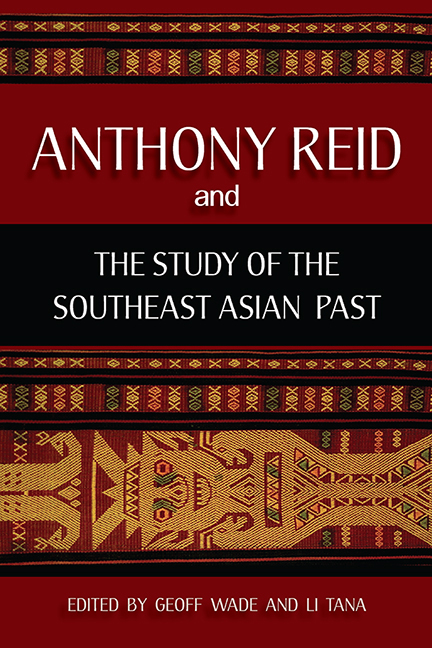Book contents
- Frontmatter
- Contents
- Acknowledgements
- The Contributors
- PART I Introduction
- PART II The Scholarship of Anthony Reid
- PART III Southeast Asia in the World
- 3 Southeast Asia and Eurasia during a Thousand Years
- 4 A Two-Ocean Mediterranean
- 5 The Concepts of Space and Time in the Southeast Asian Archipelago
- 6 Dominion over Palm and Pine: Early Indonesia's Maritime Reach
- PART IV Early Modern Southeast Asia
- PART V Modern Southeast Asia
- Appendix
- Index
- Plate section
6 - Dominion over Palm and Pine: Early Indonesia's Maritime Reach
from PART III - Southeast Asia in the World
Published online by Cambridge University Press: 21 October 2015
- Frontmatter
- Contents
- Acknowledgements
- The Contributors
- PART I Introduction
- PART II The Scholarship of Anthony Reid
- PART III Southeast Asia in the World
- 3 Southeast Asia and Eurasia during a Thousand Years
- 4 A Two-Ocean Mediterranean
- 5 The Concepts of Space and Time in the Southeast Asian Archipelago
- 6 Dominion over Palm and Pine: Early Indonesia's Maritime Reach
- PART IV Early Modern Southeast Asia
- PART V Modern Southeast Asia
- Appendix
- Index
- Plate section
Summary
The first five words of the above title are taken from a poem by Rudyard Kipling which until rather recently was well-known in Australia, where its words were sung every Anzac Day in commemoration of the deaths of many young compatriots in bygone but not forgotten battles of the British Empire. In this poem Kipling reflects on how an excess of imperial pride might see the mighty British Empire pass away like its predecessors, and extols humility and contrition. Kipling's empire was based on British supremacy at sea. So was the much earlier dominion to be described here, which also extended over palm — not just the Indonesian ones, but also the Madagascan ones, so perhaps one should say ‘palm and baobab’ — and pine, a Japanese one.
In this paper, after briefly sketching Indonesia's maritime reach, I will also argue that it is not simply meaningless to classify Indonesia as ‘Southeast Asian’ but is in fact a major barrier to any real understanding of its history.
On what criteria might one judge the coherence of a portfolio category such as ‘Europe’ or ‘Southeast Asia’? Some obvious ones suggest themselves: cultural and religious commonality, linguistic commonality, and political unification, of which Europe has the first two, with the great predominance of Indo-European languages, and of Christianity for the last two millennia. It scores less consistently over time with regards to political unification, since the significant achievements of the Romans were not maintained thereafter, though the constant competitive striving for pan-European empire, especially in the period from Napoleon to Hitler, has allowed historians to pin their narrative to an account of the resultant warfare. Southeast Asia has none of these things.
This lack of any of the unifying factors that make ‘Europe’ a coherent category causes major problems for historians of Southeast Asia. Attempts are generally made to solve these by one of the following strategies: breaking up Southeast Asia and dealing with the component parts separately; adopting a pars pro toto strategy; or attempting to generalize across the whole of Southeast Asia. These generalizations usually have to be very broad indeed to capture all of Southeast Asia and hence are hardly ever peculiar to it. Owen4 for example oscillates between the first and last strategies, the latter clearly demonstrating the sort of generalization that results.
- Type
- Chapter
- Information
- Anthony Reid and the Study of the Southeast Asian Past , pp. 101 - 122Publisher: ISEAS–Yusof Ishak InstitutePrint publication year: 2012



